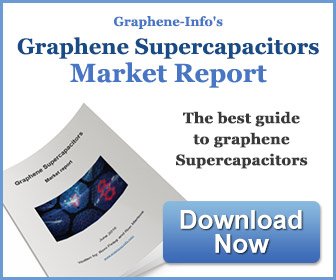Graphene supercapacitors
Graphene is a thin layer of pure carbon, tightly packed and bonded together in a hexagonal honeycomb lattice. It is widely regarded as a âwonder materialâ because it is endowed with an abundance of astonishing traits: it is the thinnest compound known to man at one atom thick, as well as the best known conductor. It also has amazing strength and light absorption traits and is even considered ecologically friendly and sustainable as carbon is widespread in nature and part of the human body.
Graphene is often suggested as a replacement for activated carbon in supercapacitors, in part due to its high relative surface area (which is even more substantial than that of activated carbon). The surface area is one of the limitations of capacitance and a higher surface area means a better electrostatic charge storage. In addition, graphene based supercapacitors will utilize its lightweight nature, elastic properties and mechanical strength.
A Graphene supercapacitor is said to store almost as much energy as alithium-ion battery, charge and discharge in seconds and maintain all this over tens of thousands of charging cycles. One of the ways to achieve this is by using a a highly porous form of graphene with a large internal surface area (made by packing graphene powder into a coin-shaped cell and then dry and press it).
What are supercapacitors?
Supercapacitors, also known as EDLC (electric double-layer capacitor) or Ultracapacitors, differ from regular capacitors in that they can store tremendous amounts of energy.
A basic capacitor usually consists of two metal plates, separated by an insulator (like air or a plastic film). During charging, electrons accumulate on one conductor and depart from the other. One side gains a negative charge while the other side builds a positive one. The insulator disturbs the natural pull of the negative charge towards the positive one, and that tension creates an electric field. Once electrons are given a path to the other side, discharge occurs.
Supercapacitors also contain two metal plates, only coated with a porous material known as activated carbon. They are immersed in an electrolyte made of positive and negative ions dissolved in a solvent. One plate is positive and the other is negative. During charging, ions from the electrolyte accumulate on the surface of each carbon-coated plate. Supercapacitors also store energy in an electric field that is formed between two oppositely charged particles, only they have the electrolyte in which an equal number of positive and negative ions is uniformly dispersed. Thus, during charging, each electrode ends up having two layers of charge coating (electric double-layer).
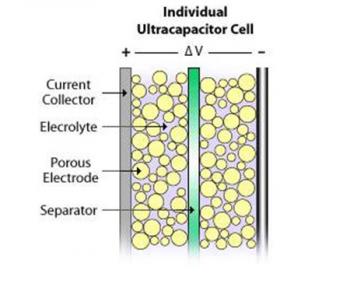
Batteries and Supercapacitors
Unlike capacitors and supercapacitors, batteries store energy in a chemical reaction. This way, ions are inserted into the atomic structure of an electrode, instead of just clinging to it like in supercapacitors. This makes supercapacitors (and storing energy without chemical reactions in general) able to charge and discharge much faster than batteries. Due to the fact that a supercapacitor does not suffer the same wear and tear as a chemical reaction based battery, it can survive hundreds of thousands more charge and discharge cycles.
Supercapacitors boast a high energy storage capacity compared to regular capacitors, but they still lag behind batteries in that area. Supercapacitors are also usually more expensive per unit than batteries. Technically, it is possible to replace the battery of a cell phone with a supercapacitor, and it will charge much faster. Alas, it will not stay charged for long. Supercapacitors are very effective, however, at accepting or delivering a sudden surge of energy, which makes them a fitting partner for batteries. Primary energy sources such as internal combustion engines, fuel cells and batteries work well as a continuous source of low power, but cannot efficiently handle peak power demands or recapture energy because they discharge and recharge slowly. Supercapacitors deliver quick bursts of energy during peak power demands and then quickly store energy and capture excess power that's otherwise lost. In the example of an electric car, a supercapacitor can provide needed power for acceleration, while a battery provides range and recharges the supercapacitor between surges.
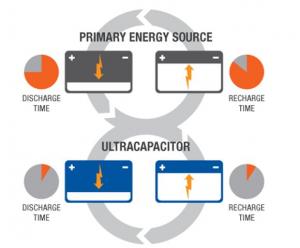
Common supercapacitor applications
Supercapacitors are currently used to harvest power from regenerative braking systems and release power to help hybrid buses accelerate, provide cranking power and voltage stabilization in start/stop systems, backup and peak power for automotive applications, assist in train acceleration, open aircraft doors in the event of power failures, help increase reliability and stability of the energy grid of blade pitch systems, capture energy and provide burst power to assist in lifting operations, provide energy to data centers between power failures and initiation of backup power systems, such as diesel generators or fuel cells and provide energy storage for firming the output of renewable installations and increasing grid stability.
Rivaling materials
Several materials exist that are researched and suggested to augment supercapacitors as much (or even more than) graphene. Among these materials are: hemp, that was used by Canadian researchers to develop hemp fibers that are at least as efficient as graphene ones in supercapacitor electrodes, Cigarette filters, which were used by Korean researchers to prepare a material for supercapacitor electrodes that exhibits a better rate capability and higher specific capacitance than conventional activated carbon and even higher than N-doped graphene or N-doped CNT electrodes.
Graphene supercapacitors commercialization
Graphene supercapacitors are already on the market, and several companies, including Skeleton Technology, the CRRC, ZapGoCharger, and Angstron Materials are developing such solutions. Read our Graphene Supercapacitors market report to learn more about this exciting market and how graphene will effect it.
Further reading
The latest graphene supercapacitor news:
A graphene industry, market and new conference series interview with Dr. Khasha Ghaffarzadeh
Our friend Dr. Khasha Ghaffarzadeh, a well respected graphene market analyst, is launching a new service called TechBlick that is a subscription-based online and all-year round event focused on advanced materials such as graphene, 2D materials, CNTs, boron nitrides, QDs, and more.
Graphene-Info partnered with TechBlick, to provide our readers an exclusive 25% discount on the TechBlick subscription. We took advantage of this launch to discuss the graphene market and industry with Dr. Ghaffarzadeh and also discuss the new service.
Hello Kasha. How do you see the graphene market shaping up in 2021?
I have closely followed and examined the graphene industry for a full decade. The landscape has certainly changed. Many companies have come and gone, and many once considered revolutionary applications are now ruled out, but overall, the industry is now at a tipping point.
We think 2021/2022 will be a turning point, setting the industry on its growth path, despite the delays caused these past 12 months due to Covid. For some, these delays have been painful as projects were pushed back or partners or customers dropped graphene to focus on other core areas. Many undershot their growth expectations, and some had difficult cash flow situations.
New graphene hybrid material could open the door to highly efficient supercapacitors
A research team working with Roland Fischer, Professor of Inorganic and Metal-Organic Chemistry at the Technical University Munich (TUM), has developed a highly efficient supercapacitor based on a novel, powerful and sustainable graphene hybrid material that reportedly has comparable performance data to currently utilized batteries.
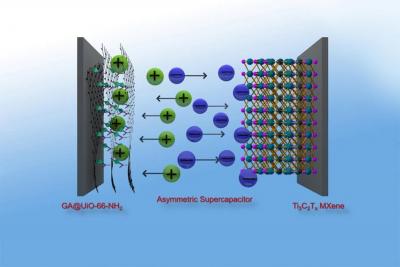 Graphene hybrid made from metal organic frameworks (MOF) and graphenic acid make an excellent positive electrode for supercapacitors, which thus achieve an energy density similar to that of nickel-metal hydride batteries. Credit: Prof. Dr. J. Kolleboyina
Graphene hybrid made from metal organic frameworks (MOF) and graphenic acid make an excellent positive electrode for supercapacitors, which thus achieve an energy density similar to that of nickel-metal hydride batteries. Credit: Prof. Dr. J. Kolleboyina
A common problem with supercapacitors to date was their lack of energy density. While lithium accumulators reach an energy density of up to 265 Kilowatt hours (KW/h), supercapacitors thus far have only been able to deliver a fraction of that. The team working with TUM's Roland Fischer has now developed a novel, powerful as well as sustainable graphene hybrid material for supercapacitors. It serves as the positive electrode in the energy storage device. The researchers are combining it with a proven negative electrode based on titan and carbon.
Graphene enables stretchable micro-supercapacitors to self-power wearable devices
An international team of researchers, led by Huanyu "Larry" Cheng, a Professor at Penn State, has used graphene to design a stretchable system that can harvest energy from human breathing and motion for use in wearable health-monitoring devices.
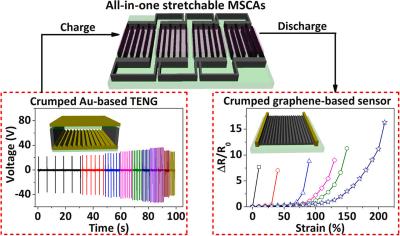
According to Cheng, current versions of batteries and supercapacitors powering wearable and stretchable health-monitoring and diagnostic devices have many shortcomings, including low energy density and limited stretchability. "This is something quite different than what we have worked on before, but it is a vital part of the equation," Cheng said, noting that his research group and collaborators tend to focus on developing the sensors in wearable devices. "While working on gas sensors and other wearable devices, we always need to combine these devices with a battery for powering. Using micro-supercapacitors gives us the ability to self-power the sensor without the need for a battery."
Researchers shed light on ionic interactions with graphene and water
Researchers led by Northwestern University engineers and Argonne National Laboratory scientists have reached new findings regarding the role of ionic interaction within graphene and water. Their insights could open the door to the design of new energy-efficient electrodes for batteries or provide the backbone ionic materials for neuromorphic computing applications.
"Every time you have interactions with ions in matter, the medium is very important. Water plays a vital role in mediating interactions between ions, molecules, and interfaces, which lead to a variety of natural and technological processes," said Monica Olvera de La Cruz, Lawyer Taylor Professor of Materials Science and Engineering, who led the research. "Yet, there is much we don't understand about how water-mediated interactions are influenced by nanoconfinement at the nanoscale."
Researchers design ultra-thick 3D graphene frameworks for high-performance flexible micro-supercapacitors
A group of researchers, led by Prof. WANG Zhenyang from the Institute of Solid State Physics of the Hefei Institutes of Physical Science (HFIPS), has reported a novel graphene-based method to prepare high-performance supercapacitors with ultra-high energy storage density.
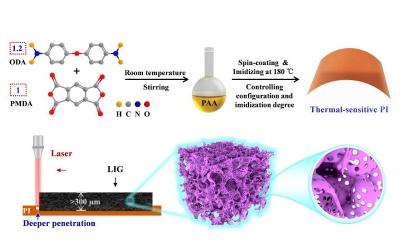 Schematic illustration for the improved laser inducing growth process of ultra-thick 3D graphene frameworks with hierarchical pores. (Image by CAS)
Schematic illustration for the improved laser inducing growth process of ultra-thick 3D graphene frameworks with hierarchical pores. (Image by CAS)
The team explained that constructing 3D graphene frameworks with ultra-thickness and rich ion transport paths is of great significance for the practical application of graphene supercapacitors. However, in thicker electrodes, the overall energy storage capability is limited by insufficient delivery of ions to the electrode material surface and the poor electron transport properties.
Integrated Graphene launches 3D graphene foam and raises almost USD$4 million
 Integrated Graphene (formerly known as RD Graphene), developers of hyper-sensitive 3D graphene foam electrodes, have set their aims on the human diagnostics market and are aiming to enable better biosensors with improved performance and speed. The company has launched its flagship 3D graphene foam process in their first product, Gii-Sens.
Integrated Graphene (formerly known as RD Graphene), developers of hyper-sensitive 3D graphene foam electrodes, have set their aims on the human diagnostics market and are aiming to enable better biosensors with improved performance and speed. The company has launched its flagship 3D graphene foam process in their first product, Gii-Sens.
The company launched its first product in conjunction with its new Integrated Graphene brand, in hopes that these steps will mark the first steps on an ambitious commercial journey to establish themselves as a leading producer of pure 3D graphene foam. In addition, the Company led a funding round in which it has raised £3.1 million (almost USD$4 million). This latest investment round follows £300,000 in seed funding from six private investors in March 2019, plus a variety of grant funding totaling £1.8m raised since 2014.
Skeleton Technologies raises €41.3 million in equity round
Estonian startup Skeleton Technologies has raised â¬41.3 million ($48.5 million) in Series D financing round, bringing its total capital raised to over â¬93 million ($109 million).
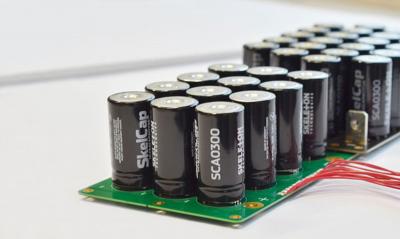
New investors include leading European industrial investors and a group of entrepreneurs "that grew payments company Adyen from its inception to successful IPO", according to reports from Skeleton. In addition, all existing investors in the company joined the equity raise: EIT InnoEnergy early investors in European gigafactory startup Northvolt â FirstFloor Capital, MM Grupp and Harju Elekter.
Researchers develop graphene-based supercapacitor to power wearable skin sensors
Researchers from the Daegu Gyeongbuk Institute of Science and Technology in South Korea have recently developed a low-cost energy storage device to power electronic devices like wearable skin sensors. The supercapacitor, made with graphene ink that is sprayed onto flexible substrates, can be used for remote medical monitoring and diagnosis on wearable devices.

Materials scientist Sungwon Lee shared that as the demand for wearable devices and remote diagnosis has increased, scientists have focused on developing electronic skin devices. The team focused on "extremely tiny and flexible energy devices as a power source."
Graphene-Info updates all its graphene market report
Today we published new versions of all our graphene market reports. Graphene-Info provides comprehensive niche graphene market reports, and our reports cover everything you need to know about these niche markets. The reports are now updated to October 2020.
The Graphene Batteries Market Report:
- The advantages using graphene batteries
- The different ways graphene can be used in batteries
- Various types of graphene materials
- What's on the market today
- Detailed specifications of some graphene-enhanced anode material
- Personal contact details into most graphene developers
The report package provides a good introduction to the graphene battery - present and future. It includes a list of all graphene companies involved with batteries and gives detailed specifications of some graphene-enhanced anode materials and contact details into most graphene developers. Read more here!
Skeleton Technologies working on graphene “SuperBattery” for EVs, signs €1 billion LOI with a leading automotive manufacturer
 Estonian startup Skeleton Technologies is reportedly developing a graphene-enhanced SuperBattery that can be charged in just 15 seconds, and can go through hundreds of thousands of charge-recharge cycles without degrading. It was also reported that Skeleton recently signed a â¬1 billion letter of intent with a leading automotive manufacturer to bring the technology to market, most likely in 2023 according to Taavi Madiberk, founder and chief executive of Skeleton.
Estonian startup Skeleton Technologies is reportedly developing a graphene-enhanced SuperBattery that can be charged in just 15 seconds, and can go through hundreds of thousands of charge-recharge cycles without degrading. It was also reported that Skeleton recently signed a â¬1 billion letter of intent with a leading automotive manufacturer to bring the technology to market, most likely in 2023 according to Taavi Madiberk, founder and chief executive of Skeleton.
This will be a key enabler of the energy transition, says Madiberk. In most cases we see that batteries are not able to fully replace the older technologies â we still have hybrid vehicles or the need for backup generators.
Pagination
- Previous page
- Page 7
- Next page
